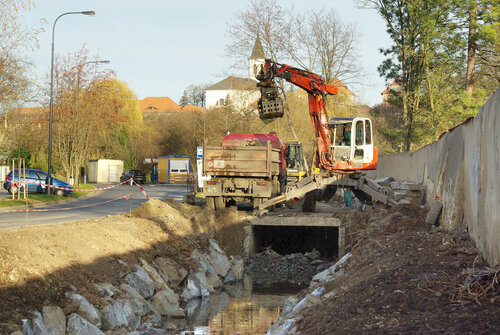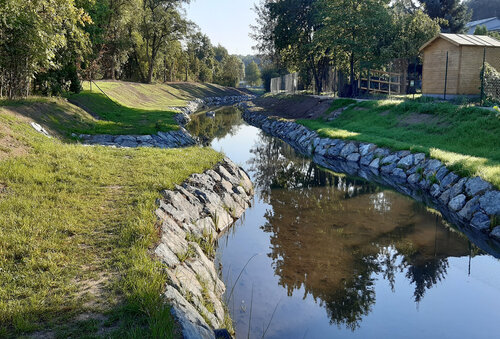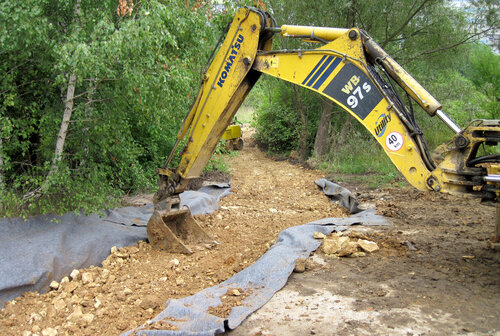The Journal is published by the Nature Conservation Agency of the Czech Republic in cooperation with the Cave Administration of the Czech Republic, the Krkonoše Mts. National Park Administration, the Bohemian Forest Mts. National Park Administration, the Podyjí National Park Administration and the The Bohemian Switzerland National Park Administration. It has been published since 1946.
cs / en
Nature Conservation 2021 — 10. 6. 2021 — Nature and Landscape Management — Print article in pdf
Water Retention in Urban Agglomerations

When mentioning the water retention, it mostly is related to water management in the open landscape. From a long-term point of view, a lot of issues should be improved and enhanced there, but water can be very well managed also in urban agglomerations. Historically, the priority in towns and cities had been to safely and as soon as possible drain off water from there. The efforts, of course, resulted in significant interventions into watercourse beds and consequently in adjacent floodplains, thus influencing the water regime.
Historical views
In Prague, an increasing in watercourse capacity (increase in cross-section of the flow) had been implemented as soon as in the 19th century, when particularly lower stretches of the Rokytka, Botič, Daleje or Motol Brooks, i.e. the biggest Prague brooks, were closed into riverbank walls and sometimes they totally disappeared under ground. The main reason for these activities was to protect adjacent built-up areas against floods and to gain new land to be built-up. Other new increasing in the watercourse capacity was carried out in connection with housing estate building in the mid-20th century. On the other hand, due to the building the prefab housing estates many water retention reservoirs collecting water from paved surfaces were established in Prague. At present, such project has not been unfeasible. Filling brook and river floodplains with everything what had not been needed in the city, from building rubble and construction waste up to boiler ash from a heating plant, was another important shortcoming. Thus, many sites/areas where water could harmlessly spill over and do not harm the city were lost.

Launching the Litovice-Šárka Brook near the Hvězda/Star game-keeping preserve.
©Jiří Karnecki
Brooks for life
The current view of water retention in towns or cities is completely different. Starting with obligations of building owners to infiltrate or retain rainfall water and only consequently to drain off it to watercourses (the obligations is directly pursuant to the Prague building regulations which are binding for every building owner) to extensive restoration of brooks and their floodplains. Due to the long-term Brooks for Life project implemented across the whole Prague´s territory and aiming at brook restoration in the city, some society-wide demand for water ecosystem restoration has been created in Prague. Citizens begun to consider water as a city´s integrated part and space with high aesthetic value, at the same time suitable for rest and restoration.

The Rokytka Brook restoration below the Čihadla site.
©Jiří Karnecki
Although the Brooks for Life project was launched in 2005, its beginning can be dated back to the late 1990s. At that time, the Capital City of Prague became a managing authority of some small watercourses which had previously been in charge of the Prague Sewerage and Watercourses, state enterprise. The new manager immediately commissioned some big restoration studies, e.g. those on the Litovice-Šárka Brook in Liboc and Ruzyně city quarters, Nebušice Brook, Řepy Brook, etc. Despite the fact that the approach was quite revolutionary (even if the individual solutions were conform to the time) the projects were due to huge extent and unfinished property rights doomed. Moreover, after some years, some individual partial stretches have been successfully implemented, but with completely different concept.
The beginning of new millennium was a substantial milestone because the team dealing with the issue and led by Tomáš Just participated in some field excursions to water ecosystem restoration projects in Bavaria. The participants were amazed at the simplicity, naturalness and ideas of the projects carried out there. It was clear that in Bohemia and particularly in Prague there it had a lot of catching up to do.
First projects
To avoid mistakes made by the predecessors proposing indiscussable projects, the team first of all selected a suitable area/site owned by the Capital City of Prague which could be relatively easily restored. The Čihadla dry polder covering 19 hectares where three brooks, namely the Rokytka, Hostavice and Svépravice ones, were straightened and channelized in the 1980s seemed to be ideal. The project documentation was elaborated by the Ekotechnik Inženýring Company Ltd. and in 2008, the building was made with support from the European Union´s funds. The finished building has been appreciated by the general public and experts, presented on some expert conferences and workshops and visited by many excursions. Just as a matter of interest, the project has been living and in addition to building new pools for amphibians every year, other three small water reservoirs have been established there, the Svépravice Brook restoration has been prolonged, inert waste made-up ground with a dog-training grounds was eradicated and nature-based management on meadows including cattle grazing has been introduced there.

Building the Řepy Brook bed.
©Jiří Karnecki
The other important project was opening the arched Litovice-Šárka Brook bed along the Hvězda/Star game-keeping preserve in 2010. The brook was arched in relation to building the Džbán/Jug water reservoir used for recreation. The reason officially presented for the bottomless arch culvert was improving water quality and elimination of contamination/pollution sources. It was just one of the fragments from the project commissioned as early as in the 1990s which had been negotiated more than ten years. For the first time in Prague, heavy stone-packing from boulders weighing up to 500 kilograms was applied there. Therefore, just shortly before starting the project, there was an indignation levelled against the project among local people. Finally, they were convinced by the finished building itself. Due to high costs, accounting for CZK 10 million (EUR 390,000.00), of them most were spent for demolition of huge concrete constructions, a study on the return of investments of the project from a point of view of ecosystem services was commissioned. The results showed that due to climate change mitigation and adaptation, the return was 9.5 years.
The success of both the projects stimulated another more extensive action, this time again on the Litovice-Šárka Brook. Three abandoned historical meadows, namely at Žežulka, Zlatnice and Jenerálka owned by the Capital City of Prague which had been overgrown by reed and self-seeding vegetation were chosen in the Šárka Valley. In addition, the brook had been shifted to a valley margin and straightened followed a road there. In 2013, the brook was successfully brought back into the floodplain meadows. Thanks to this action, many remarkable and specially protected wild plant and animal species which had been surviving there were saved. Currently, due to the restoration and consequent management they have spreading across the site. The Common frog (Rana temporaria) is a flagship species there: thanks to a set of pools at Jenerálka, its vanishing population was saved and at present, up to some hundreds of individuals have been reproducing at the site.
Restoration on the Rokytka Brook – An outdoor classroom
Extensive restoration of the Rokytka Brook from the Kyje to Vysočany city quarters just displays a natural classroom of water ecosystem restoration. On the five-kilometre- long stretch, bringing a meandering brook back into a floodplain meadow, stretches reinforced by stone-packing, one-side broadening of the bed, boulder slides, stone built-ins to split the bed, dead wood application, pools and walls for kingfishers can be seen. The last addition is an increasing in the Rokytka Brook capacity in the Kyje city quarter where a part of land plots had been purchased from private owners and an ecological narrow terrace up to 10 meters wide for directing flood flows was built. The Rokytka Brook itself was divided and stabilized by the stone-packing.
Thanks to presenting the Rokytka Brook restoration, awareness of stone-packing as a suitable nature-based solution in stabilizing watercourse beds has been raised. Similarly to the Čihadla dry polder restoration, all the projects have been continuing and further stages of these restoration actions have been under preparation.
Restoration of vanished brooks
Within the Brooks for Life project, attention was paid to the Řepy Brooks. I the 1950s, there had still been some fishponds fed by the Řepy Brook in the Řepy city quarter. Due to building development, fishponds were step-by-step conversed and the brook itself vanished. Therefore, the only fishpond called Prasečák/Hog Pen and a small part of the brook´s dried bed near the fishpond remembering that once there was a brook there left by the 21st century there.
Efforts to bring the brook back dated back to the 1990s and among Prague watercourse restorations, this is the most lasting one. In 2014, the last acceptances had been finally gained and the project´s implementation could begin. The adjacent Hliník Lake has become a water source. Getting over a railroad and a road by controlled boreholes below them was a piece of cake compared to building a new open bed. The project clearly demonstrated the difficulties related to building a new brook in an urban area. Below approx. 0.5 m soil layer a concrete slab had been found: thus, building a new bed resembled more building a pavement than a brook. Therefore, the concrete slab had to be put away and an excavation was filled by clayey soil; only in such prepared corridor a new bed of the Řepy Brook could be ditched. Now, the area has become overgrown by vegetation, refreshing the nearby Řepy housing estate.
In 2017, another bringing back a vanished brook was implemented on the Brusnice Brook in a green strip along Patočka Street where the brook had been historically piped. It was a 900–meter–long stretch where an open bed accounted for 620 meters. Based on the experience raised during the Řepy Brook restoration, possible occurrence of landfills and waste disposal sites had been expected there. Thus, a bed sealed with a clay layer and protected by a gravel riprap was proposed from the project´s very beginning. Moreover, at the beginning of excavation works unknown heat line and water supply and piping were discovered there: later it was found that both the facilities have been defunct, so they could be abolished. Consequently, activities followed the project´s plan and at present the Brusnice Brook water has been flowing through a new open bed.
The author´s experience confirmed that building new brook beds in a built-up area is quite complicated and the fact should be in advance taken into account. At least it is necessary to consider larger or smaller sealing of the beds because the terrain in a built-up has been modified so that there could be historical landfills and waste disposal sites which are mostly well permeable: therefore, brook water can be disappearing. Crossing the underground utilities and services which are often built in various depths could also make difficulties: the fact should be reported by land plot manager. Nevertheless, most of these difficulties can be solved. Thus, there should be no worries to bring water back to the surface and near it to citizens.
Current restoration
The Říčanka Brook near the municipality of Lítožnice had long ago lost its natural character. Maps drawn in 1848 show that the bed was quite straightened. The brook modifications could be related to building the original Lítožnice Fishpond or with the necessary use of farmland in the brook´s floodplain.

The Říčanka Brook and its floodplain below the Litožnice Fishpond.
©Jiří Karnecki
In the 1960s, the brook was channelized by wood small fences because in the past such a measure was considered as close-to-nature channelizing: nowadays, we should not be satisfied with this. The stabilization possibly be done in relation to amelioration of adjacent plots of land.
Within the Landscaping the confluence of the Rokytka and Říčanka Brooks project, the whole Říčanka stretch on the lands owned by the Capital City of Prague was proposed to be restored. The brook near a fishpond left its original bed and for the restoration, the whole brook´s floodplain was used. The length of the new bed accounts for 1,075 and the brook was lengthened by 300 meters. The new meandering bed was supplemented by a set of larger and smaller pools in total covering 5,980 m2 and retaining 2,169 m3 of water. In a pool, a bank was shaped so that a vertical wall for kingfishers was created. Wade stretches were stabilized by a stone riprap and trees which had had to be fallen down were used as dead wood both in the brook and the pools. The original brook bed was – except one site where a pool was created – filled. Because the floodplain had been in the past used as arable land, the whole area was sown by a grass mixture of herb-rich meadows. Two wades from stone-packing and two ceiling pedestrian bridges were also built there.
In this case, the author had a fiddle with numbers. In addition to making the brook bed longer and creating a system of pools, he compared the water volume in the original bed during a ordinary flow and that in the restored bed. In the latter, 2.5 times more water than in the former is captured. Thus, this is a clear indicator on necessity and suitability of water ecosystem restoration projects.
Conclusions
Due to the increasing number of watercourses restored, the awareness of water ecosystem restoration among the general public has been significantly raised and Prague citizens can enjoy themselves the benefits provided by the restoration. In other words, they can physically touch the water. Thus, in Prague, there has been the society-wide demand for water ecosystem restoration and some hundreds of meters of watercourse beds are restored each year and new projects have been becoming more and more ambitious. Inter alia, extensive restoration of the Rokytka and Běchovice Brooks as well as connecting the Berounka River and the Krňák cut-off meander at the Lipence city quarter have been under preparation.
For more detail on the water ecosystem restoration projects in Prague, see
www.praha-priroda.cz.

